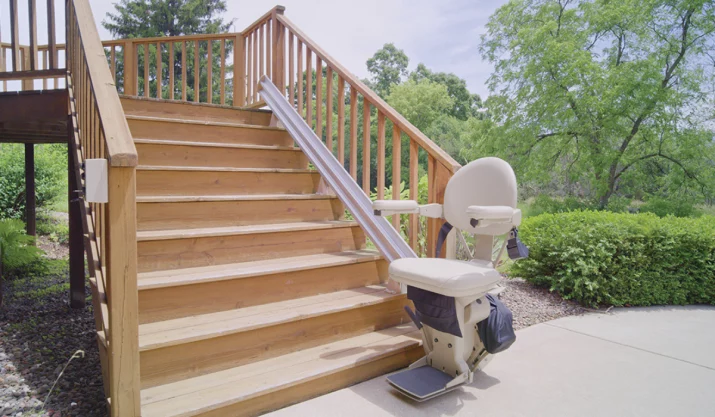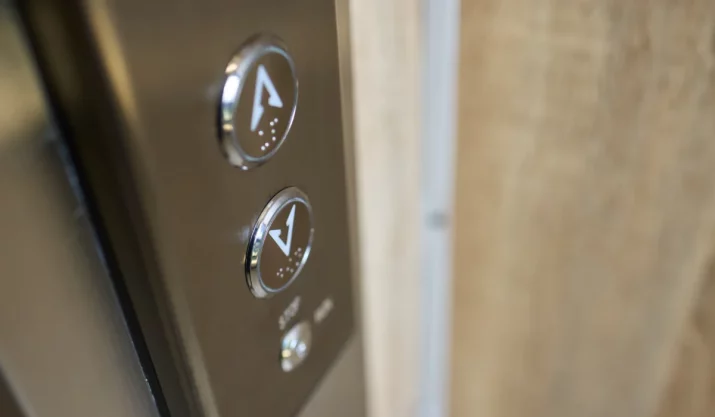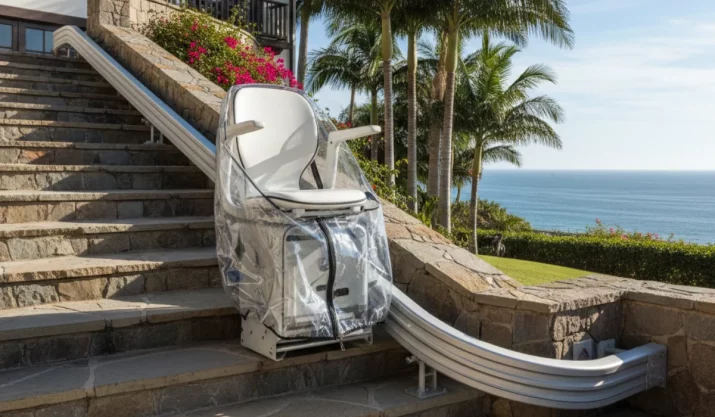Tips for Keeping Your Outdoor Lift Safe from the Elements

Table of Contents
- Key Takeaways
- Use a Weather-Resistant Lift Cover
- Clear Obstructions and Debris Regularly
- Stick to a Lubrication Schedule
- Schedule Professional Lift Maintenance Services
- Monitor for Signs of Wear and Act Early
- Keep Your Lift Powered and Protected
- Plan for Seasonal Changes
- Count On Local Experts for Outdoor Lift Care
Living in California means sunshine, salt air, and seasonal rain, sometimes all in the same week. If you or a loved one relies on an outdoor stairlift or porch lift, you know that weather conditions can have a direct impact on safety, comfort, and the functionality of your equipment.
Without regular maintenance, exposure to the elements can cause breakdowns, shorten the lifespan of your lift, and lead to costly repairs.
This guide offers practical tips to help you protect your outdoor lift, whether it’s a platform lift for a wheelchair or an outdoor stairlift, so it stays in good working condition year-round.
Key Takeaways
- A good lift cover protects against sun, rain, and dirt that can wear down your outdoor stairlift fast.
- Clearing debris and keeping parts lubricated helps your lift move smoothly and prevents damage from everyday weather.
- Catching signs of trouble early keeps your lift safe, avoids breakdowns, and helps protect your manufacturer’s warranty.
- Power protection and seasonal planning help your lift stay reliable through storms, blackouts, and extreme weather changes.
Use a Weather-Resistant Lift Cover
Even if your lift is rated for outdoor use, that doesn’t mean it’s immune to moisture, UV rays, or debris. A high-quality, weather-resistant lift cover can go a long way in reducing wear and tear on the control panel, moving parts, and electrical systems.
Look for covers specifically made for your model and climate.
Coastal areas may require extra UV protection, while mountain regions might need something that can handle ice and snow.
Covering your lift when not in use is one of the easiest forms of preventative maintenance you can practice.
Clear Obstructions and Debris Regularly
Leaves, pine needles, and dirt might seem harmless, but buildup on or around the track and platform can cause malfunctions, especially after a windy day or storm.
In places like Northern California, where dry vegetation is common, debris can accumulate quickly and even create fire hazards. Use a soft brush or handheld blower to clear the track weekly.
If you live under a tree canopy, consider setting a maintenance schedule to inspect and clean your lift after each storm.
Stick to a Lubrication Schedule
Outdoor stairlifts and platform lifts have moving parts that are especially prone to wear when exposed to the elements.
Regular lubrication is key to keeping your lift operating smoothly. Use a lubricant that’s compatible with your lift’s make. Brands like Bruno often have product-specific recommendations.
Lubricate joints and tracks regularly, but don’t overdo it, as too much lubricant can attract dust and grime.
Your lift’s user manual or a certified lift service provider can guide you on the best intervals and materials to use.
Schedule Professional Lift Maintenance Services
Just like your car, your lift needs routine checkups. Partnering with a company that offers professional maintenance services can help you catch small issues before they become major malfunctions.
In Southern California, the dry air can dry out rubber seals, while up north, fog can cause rust on untreated parts. A technician will inspect electrical systems, the control panel, and safety sensors, and perform any needed calibration.
Some companies may offer custom maintenance plans so you can keep your lift in top shape with minimal downtime.
Monitor for Signs of Wear and Act Early
A squeaky ride or delayed response from the control panel isn’t just an inconvenience. It’s often a sign that your lift is headed toward a breakdown.
Ignoring these early warnings could lead to costly repairs and more extended downtime. Create a simple maintenance checklist to track small issues.
For example, if you notice your lift is moving more slowly after a rainstorm, that might indicate water intrusion. Acting early helps preserve the functionality of your equipment and can even protect your warranty in some cases.
Keep Your Lift Powered and Protected
Power supply issues are one of the most common causes of outdoor lift malfunctions. Make sure your lift’s outlet or dedicated line is grounded and shielded from rain or standing water.
In areas prone to rolling blackouts or winter storms, consider a backup power source or battery system to reduce downtime. This is especially important for users with limited mobility who rely on their lift to get in and out of the home safely.
Plan for Seasonal Changes
Whether it’s prepping for El Niño rains or the dry heat of August, planning for seasonal shifts can help protect your lift’s lifespan.
Before winter, inspect for any signs of rust, apply extra protective coatings if needed, and make sure all safety features are functioning correctly. In the summer, check for overheating components, especially on direct-sun installations.
Adapting your maintenance plan based on local seasonal patterns will extend your lift’s working condition and prevent surprises.
Count On Local Experts for Outdoor Lift Care
Protecting your outdoor stairlift or platform lift starts with attention to detail and ends with reliable service. At California Mobility, we’ve helped hundreds of California families safeguard their lifts with tailored maintenance plans and repair service options.
Whether you need help setting up a preventative maintenance schedule, inspecting for wear after a storm, or choosing a weather-resistant cover, we’re here to help.
Reach out and let’s make sure your outdoor lift is ready for whatever weather California throws its way.






